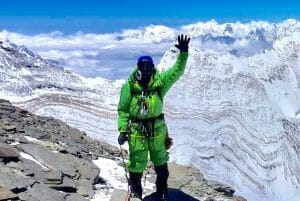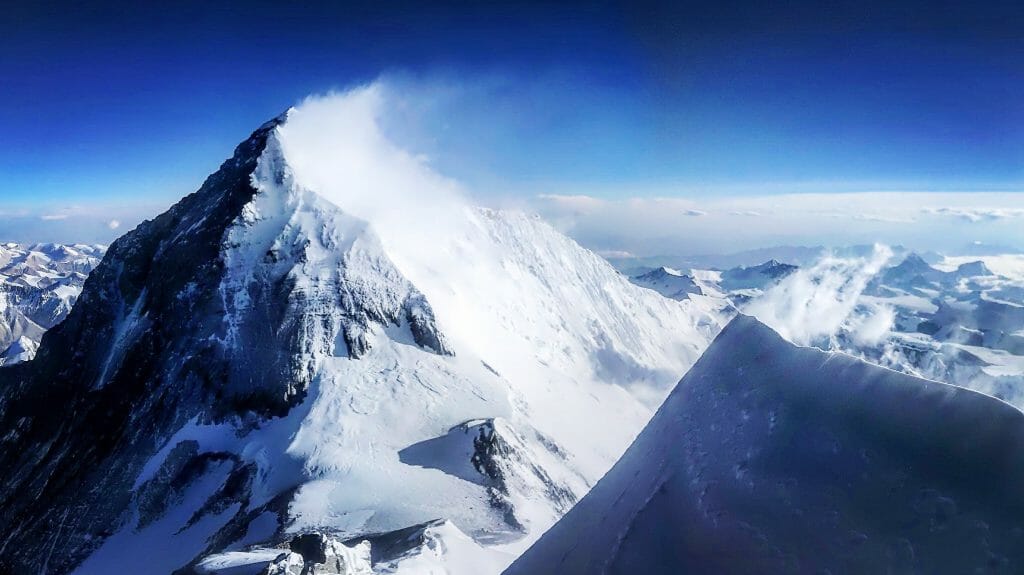In 2014, after watching a Discovery Channel docuseries about commercial climbing on Mount Everest, I texted a good friend of mine: What do you think about climbing Everest?
His response was quick and to the point: Mike, there’s no way you’re going to climb Everest.
Okay, I wasn’t going to do it the next day, and I’d have to lay down a lot of groundwork, but I believed it could be possible. I started putting together the pieces that would be required if I ever got the chance. Over a five-year span, I overhauled my life to facilitate being faster, fitter, and safer in the mountains. I became aware of my gaps—my weaknesses—and worked to fill them.
Beginning with Mount Elbrus in Russia, I started progressing through the Seven Summits. I approached each one as a stepping stone toward the next biggest peak—a logical pathway to Everest. It was never my goal to climb all seven. That was just the natural way my plan unfolded.
After canceling a trip to Denali in 2015 because I sensed my fitness was lacking, I accepted that I needed help with training. I wanted to enjoy my climbs and do them in good style. I didn’t want to just scrape by. Toward the end of 2015, I reached out to Uphill Athlete for coaching. My hope was that working one-on-one with Scott Johnston would increase my potential success percentage points on these peaks.
I thought at the beginning that I would be an easy client, but it turns out it’s hard to let go of misconceptions about fitness that have been reinforced by 30-plus years of doing things the wrong way. Why was he having me train slower and longer? What was so wrong about working hard and sweating a lot for a couple of hours? It was humiliating to have to keep my heart rate low while running, because it meant I was basically hopping down the road. I would go out at night when no one could see how slow I was moving.
“This is normal, Mike,” Scott told me early on. “If you haven’t done this before and you haven’t seen results from it, you’re going to wonder why you need to train aerobically, which at first will be slow.”
Once I got over my doubts and began to believe in the bible of Scott, the results were incredible. I climbed Mount Vinson about two months in, but it was on Denali in 2016 that I really saw the gains. I acclimatized well and had no trouble with the heavy carries. I always had energy in the tank. I had arrived prepared, and it felt incredible. This may be dark, but there is motivation in seeing other people suffer—to know that you’ve done the work and it’s paying off, to see it reflected in how others are struggling where you are having an easy time.
So much of getting ready for these big climbs is grunt work. The key is doing the grunt work intelligently.
Although I stopped working directly with Scott after Denali, I took what I’d learned and applied it to future climbs. I also reshaped my life.

At the time, I was living and working in Denmark—at sea level, no hills to speak of. My dissatisfaction with my job and home carried over into other aspects of my life, including training. I was in a rut and realized that Everest probably wouldn’t happen if I stayed where I was. In June 2017 I moved to Mexico City, which is at a lofty 7,300 feet and surrounded by 5,000-plus-meter volcanoes. Suddenly I had access to mountains on the weekends and was in a much more motivating job. That professional motivation carried over into my training.
After spending six months running, climbing, and filling in gaps in my strength (core, back, and shoulders), I began working my way through the Uphill Athlete 16-Week Big Mountain Training Plan. Initially I feared I might have an accountability problem without Scott monitoring my daily workouts. That wasn’t the case. Even as the plan ramped up in the number of hours required, I remained committed to doing the work. I had invested so much in changing careers, languages, and continents. I wasn’t willing to fail.
It looked like everything—funding, the right headspace, my fitness, the necessary time off—would line up perfectly to make Everest possible for spring 2019. The chess pieces were in place for the final move. In 2018 I doubled down on my preparation. I cut back on drinking, got my diet in a good place, and set aside time for training to the point where it became a routine. I was strict about everything I could control.
I knew Everest wasn’t going to be a walk in the park, but I began to consider upping the challenge. What about Lhotse? The outfitter I was going with supports the Everest-Lhotse linkup. If I summited Everest and felt good, I could descend to Lhotse High Camp and then summit Lhotse the following day. The thought of climbing two 8,000-meter peaks in the space of one expedition was exciting. And if I wasn’t feeling it, I could easily pull out. There was zero pressure. Everest remained the main objective. Lhotse would be a bonus.
My climbing partners for this trip, Jim and Tony (“Tac”), weren’t up for the Everest-Lhotse double. I’m in my early 40s, they’re in their 60s; Tac would turn 63 in Nepal. I had first connected with Jim on Aconcagua, and Tac joined us for Carstensz Pyramid (Puncak Jaya) in Western Papua. It was Jim’s dream to summit Everest. Tac cared less about the summit, more about going on this incredible adventure with his best friend of 42 years. The three of us would climb with two guides we knew from previous expeditions.
Jim, Tac, and I flew in to Namche Bazaar on April 9 and began our trek to Everest Base Camp (EBC). We did a few acclimatization hikes along the way and spent one night at 5,500-meter Kongma La Pass. After a couple days at EBC, we dropped back to Lobuche to summit Lobuche East (6,100 meters). During this time, I dodged the Khumbu cough and didn’t experience any altitude sickness. Then, despite my best efforts to keep well, a case of Delhi belly drained me just before our first rotation on Everest, a push to Camp 1. That was a rough day for me. Fortunately, thanks to my fitness, I bounced back from the combined stress of the stomach bug, the lack of calories, and the exertion at altitude. If I had been sick for just one more day, it could have slid the other way for me. Up there you’re always on that razor’s edge of what can go right and what can go wrong.
Jim experienced the flip side of that fine balance. Even before EBC, he had problems acclimatizing. His sleep began to suffer. He grew increasingly tired. During our rotation up to Camp 2, he made the tough call to return to Base Camp. He was so run down he knew it wasn’t safe to go farther. It was without a doubt the right decision.
My opportunity to strike for the summit—a slim one-day weather window—arrived just a few days after we returned to EBC from a drop-back to the relatively lush, thick-aired Namche Bazaar. With Jim struggling to acclimatize and Tac also needing more time to get in position for a summit bid, I was the only one ready to take advantage of it. I was sad not to go up with my friends, but we agreed it would be the best plan of attack for everybody.
On May 13, I left EBC with guide Namgya Sherpa. Together we pushed up through the Khumbu Icefall to Camps 2, 3, then 4. Along the way we teamed up with an Indian climber named Sheetal, the youngest woman to have summited Kanchenjunga, and her Sherpa guide Chhiring.
On our summit day, the four of us left Camp 4 at 9:30 p.m. We arrived on top of the world at 6:05 a.m., just after sunrise on May 16. There were very few other people up there that morning. I spent 25 minutes soaking in the views, letting my achievement begin to sink in. It was awe-inspiring and humbling, a mix of emotions I still can’t put into words.

Then the weather window slammed shut on a Lhotse linkup, and we were forced to descend to Camp 2 that same day. I figured the twofer goal of Everest and Lhotse in a single expedition was not going to happen. Moving from Camp 3 to the summit and then down to Camp 2 in the space of two days was hard work. It was also the safest way to reduce our time at altitude and thread the narrow gap in the weather. We arrived back at EBC the morning of May 17. As long and physically demanding as those days were, there was nothing that really made me suffer. For me that marks a successful climb.
Two days later, conditions improved again and I got the opportunity to summit Lhotse with Chhiring. Within one week I would climb from Base Camp to the summit of Everest and then from Base Camp to the summit of a second 8,000-meter peak. My only apprehension in heading back up was the risk of additional exposure to both the altitude and the hazards of the Khumbu Icefall. But I knew the route, and I didn’t feel beat up from my Everest ascent. At that point I was so acclimatized that I was basically a giant red blood cell. The first summit set me up for a great experience on the second summit, and a full five years of training and preparation had set me up for that first summit. It was such a long process that adding an extra couple of days to do Lhotse was almost a no-brainer.
I was there, I’d done the work. Mike, you’d be foolish not to try this.
I felt like Superman as I passed other climbers going through the Icefall. The second time up to Camp 3 without oxygen was so much easier than the first time. Chhiring and I reached the Lhotse summit at 6:30 a.m. on May 23—approximately the same minute Tac summited Everest. Although Tac and I didn’t climb together, in some ways it was still a shared experience.

There wasn’t much time for reflection while I was climbing. In the microcosm of Base Camp and on the mountain, you’re always in this fight-or-flight mode. You’re hyper-focused on what you’re doing and where you’re going that day. Decisions have life-or-death consequences. For two months I accelerated toward an objective without considering what it meant to me.
It wasn’t until I was flying over Mexico City on my way home that it began to hit me: I had pulled it off. I had executed my plan, no shortcuts. I had filled my gaps. As I gazed out the window at the lit-up sprawl of the city, I became emotional. I had sacrificed so much along my five-year journey to the summits of Everest and Lhotse. Though I was stubborn about the goal, and perhaps went too deep at times, I didn’t miss out on life. Quite the contrary. Working toward a goal that was so all-encompassing and motivating made everything richer.
I enjoyed the process—the training, the learning—as much as the summits. I embraced the discomfort, both mental and physical. Without exploring my limits, I never would have seen the world from its absolute top.
-by Uphill Athlete Mike Mulrooney Title photo: The best view of Mount Everest—from the summit of Lhotse at 6:23 a.m. on May, 23, 2019. All photos by Mike Mulrooney (Instagram: @edge.of.epic).
